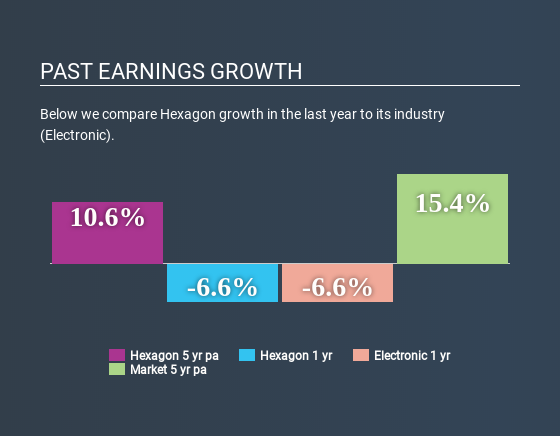Hexagon AB (publ)'s (STO:HEXA B) Stock Has Been Sliding But Fundamentals Look Strong: Is The Market Wrong?

Hexagon (STO:HEXA B) has had a rough three months with its share price down 12%. However, a closer look at its sound financials might cause you to think again. Given that fundamentals usually drive long-term market outcomes, the company is worth looking at. Particularly, we will be paying attention to Hexagon's ROE today.
Return on Equity or ROE is a test of how effectively a company is growing its value and managing investors’ money. Simply put, it is used to assess the profitability of a company in relation to its equity capital.
Check out our latest analysis for Hexagon
How Do You Calculate Return On Equity?
The formula for ROE is:
Return on Equity = Net Profit (from continuing operations) ÷ Shareholders' Equity
So, based on the above formula, the ROE for Hexagon is:
11% = €695m ÷ €6.2b (Based on the trailing twelve months to March 2020).
The 'return' is the yearly profit. So, this means that for every SEK1 of its shareholder's investments, the company generates a profit of SEK0.11.
What Has ROE Got To Do With Earnings Growth?
So far, we've learnt that ROE is a measure of a company's profitability. Depending on how much of these profits the company reinvests or "retains", and how effectively it does so, we are then able to assess a company’s earnings growth potential. Generally speaking, other things being equal, firms with a high return on equity and profit retention, have a higher growth rate than firms that don’t share these attributes.
A Side By Side comparison of Hexagon's Earnings Growth And 11% ROE
At first glance, Hexagon seems to have a decent ROE. Even when compared to the industry average of 11% the company's ROE looks quite decent. This probably goes some way in explaining Hexagon's moderate 11% growth over the past five years amongst other factors.
We then compared Hexagon's net income growth with the industry and found that the company's growth figure is lower than the average industry growth rate of 18% in the same period, which is a bit concerning.
The basis for attaching value to a company is, to a great extent, tied to its earnings growth. It’s important for an investor to know whether the market has priced in the company's expected earnings growth (or decline). Doing so will help them establish if the stock's future looks promising or ominous. One good indicator of expected earnings growth is the P/E ratio which determines the price the market is willing to pay for a stock based on its earnings prospects. So, you may want to check if Hexagon is trading on a high P/E or a low P/E, relative to its industry.
Is Hexagon Efficiently Re-investing Its Profits?
With a three-year median payout ratio of 29% (implying that the company retains 71% of its profits), it seems that Hexagon is reinvesting efficiently in a way that it sees respectable amount growth in its earnings and pays a dividend that's well covered.
Based on the latest analysts' estimates, we found that the company's future payout ratio over the next three years is expected to hold steady at 30%. Accordingly, forecasts suggest that Hexagon's future ROE will be 13% which is again, similar to the current ROE.
Summary
In total, we are pretty happy with Hexagon's performance. Particularly, we like that the company is reinvesting heavily into its business, and at a high rate of return. As a result, the decent growth in its earnings is not surprising. Having said that, looking at the current analyst estimates, we found that the company's earnings are expected to gain momentum. Are these analysts expectations based on the broad expectations for the industry, or on the company's fundamentals? Click here to be taken to our analyst's forecasts page for the company.
Love or hate this article? Concerned about the content? Get in touch with us directly. Alternatively, email editorial-team@simplywallst.com.
This article by Simply Wall St is general in nature. It does not constitute a recommendation to buy or sell any stock, and does not take account of your objectives, or your financial situation. We aim to bring you long-term focused analysis driven by fundamental data. Note that our analysis may not factor in the latest price-sensitive company announcements or qualitative material. Simply Wall St has no position in any stocks mentioned. Thank you for reading.

 Yahoo Finance
Yahoo Finance 
